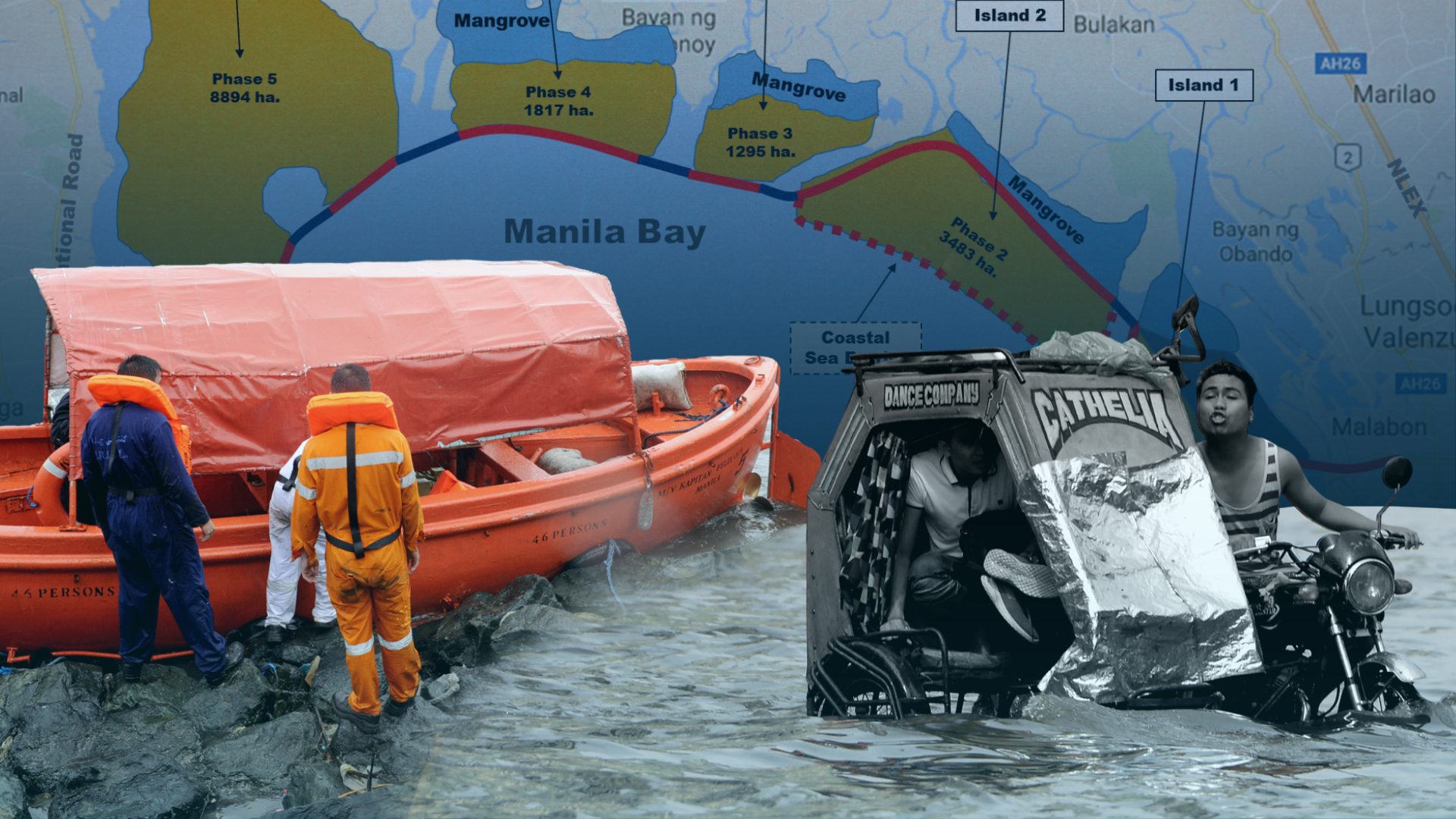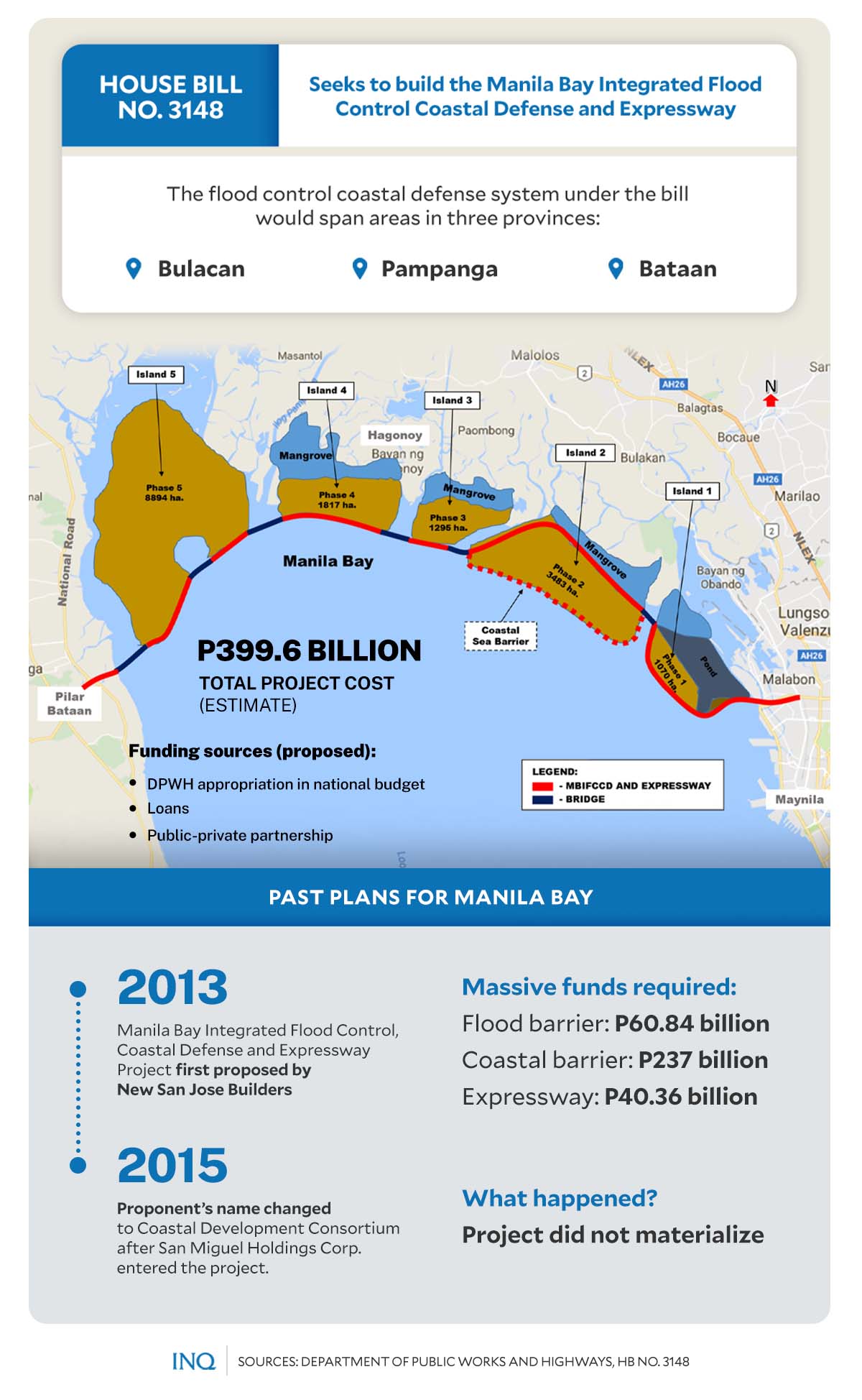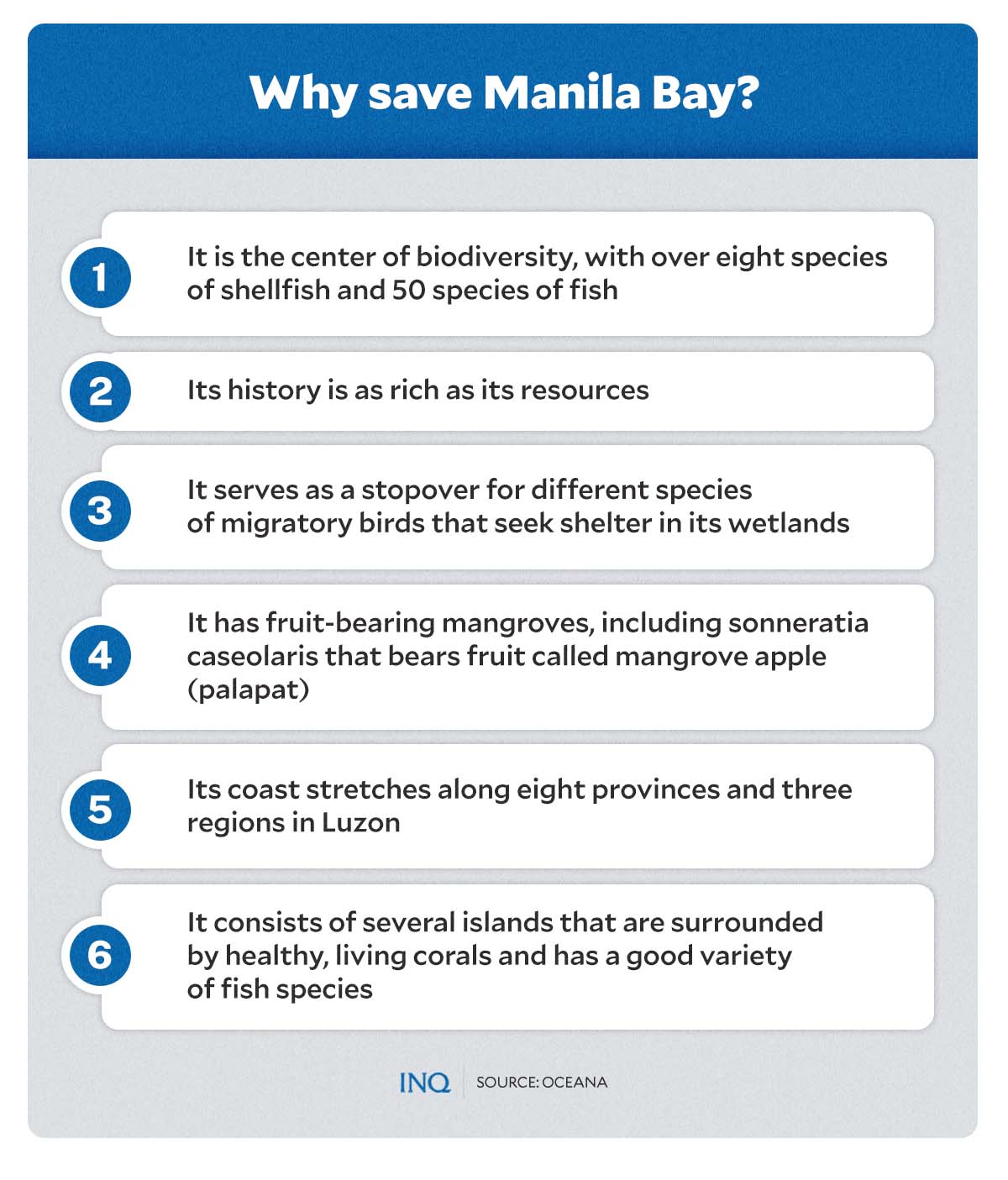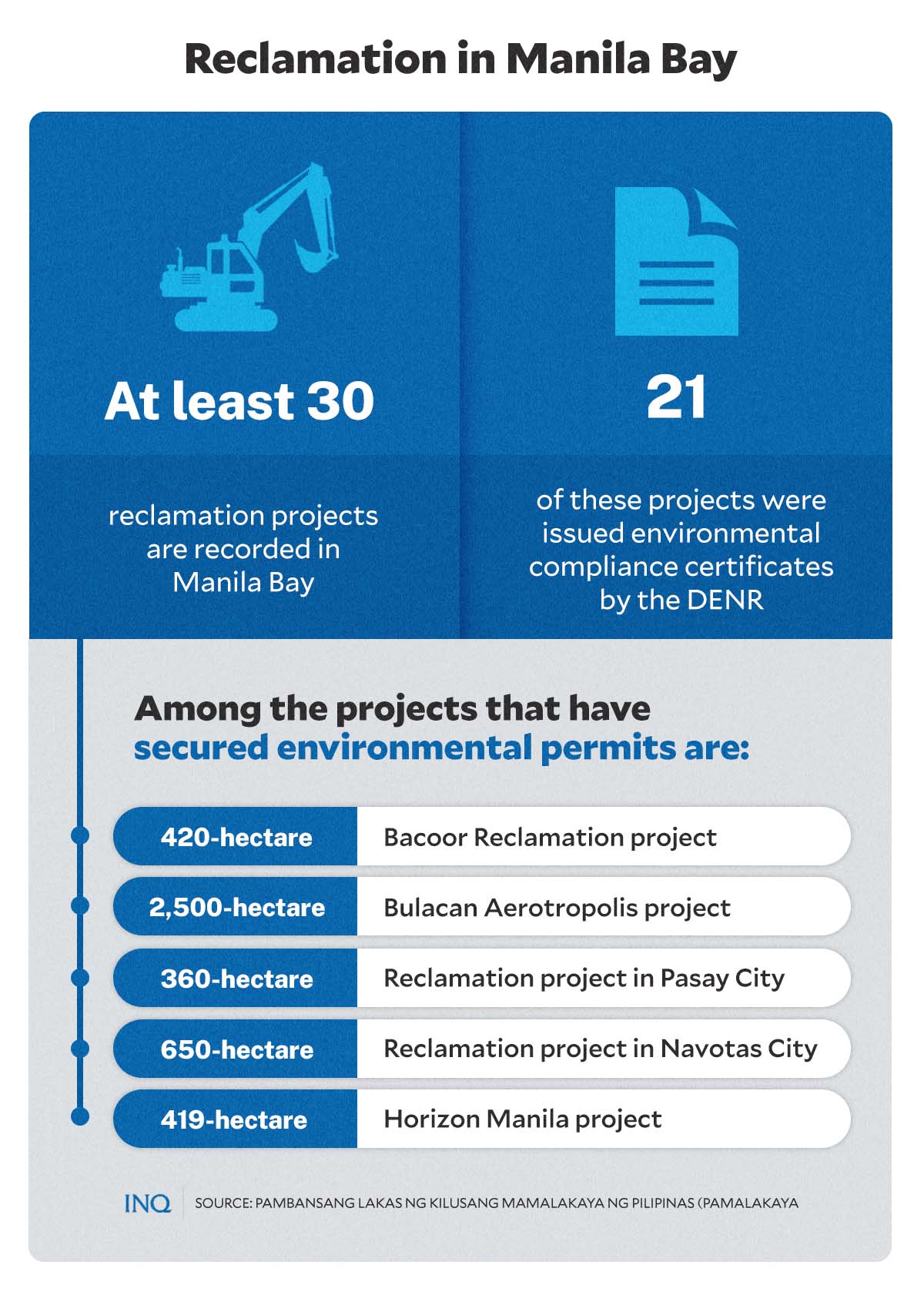More harm than good seen in revived plan to build flood control, expressway project on Manila Bay
MANILA, Philippines—A recent bill filed in Congress proposing a massive flood control system with an expressway on top is causing more alarm among environmental and marine conservation groups which continue to advocate protecting Manila Bay from damage caused by reclamation projects.
Manila Bay, a center of biodiversity that spans 199,400 hectares with a coastline that runs through the provinces of Cavite, Bulacan, and Bataan and the Metro Manila cities of Pasay, Manila, Malabon, and Navotas, is in constant threat of ecological ruin, according to environmental groups and advocates.
Despite previous claims that the bay is “a dead body of water,” several studies have pointed out that Manila Bay is “very much alive” and has a flourishing ecosystem—which consists of diverse marine resources like the vast coral covers found in the bay’s southern area, and several species of fish and shellfish deep in the bay’s waters.
READ: Manila Bay not dead, but reclamation killing it, say groups
But numerous ongoing and pending massive reclamation projects in the bay are now threatening its abundant marine resources.
According to the militant fishermen’s group Pambansang Lakas ng Kilusang Mamamalakaya ng Pilipinas (Pamalakaya), at least 30 reclamation projects have been found in Manila Bay. Of those, 21 projects have already been issued environmental compliance certificates (ECC) by the Department of Environment and Natural Resources (DENR).
Data from conservation group Oceana, citing the Philippine Reclamation Authority, also showed 22 reclamation projects along Manila Bay—half of which were already “underway” as of Feb. 28.
READ: Gov’t urged to stop all reclamation, quarrying in Manila Bay
This week, the House of Representatives deliberated some bills regarding flood control in areas in or near Manila Bay’s northern shores.
One of those bills seeks to reintroduce a previously proposed project on constructing the Manila Bay Integrated Flood Control Coastal Defense and Expressway.
Flood control project
House Bill No. 3148 proposes the establishment of a coastal defense system in Manila Bay to “protect the shoreline from future rises in the sea level,” particularly the northern part of the bay, which covers the coastal areas of Bulacan, Pampanga, and Bataan.
According to the bill, the selected coastal communities are “susceptible to flooding and are the most dangerously exposed areas as the sea level rises”—risks exacerbated by land subsidence due to “excessive groundwater extraction and rapid urban development.”
“The purpose of this bill is to shield the coastal areas of the northern Manila Bay from typhoon waves and flooding,” explained the bill’s author, Rep. Ambrosio Cruz Jr., at a meeting of the committee on public works and highways.
According to the Department of Public Works and Highway’s (DPWH) website, the project—with an estimated cost of around P399.66 billion—aims to:
- Improve adaptive capacity against city coastal flooding of northwest Metro Manila.
- Improve adaptive capacity against typhoon waves of the coastal zone in the northern part of Manila Bay.
- Increase efficiency of logistics.
- Provide space to accommodate urban growth and industrial development.
- Enhance the littoral ecological system of Manila Bay.
But for Jon Bonifacio, national coordinator of Kalikasan People’s Network for the Environment (Kalikasan PNE), the project will not address flooding and rising sea levels in the coastal areas at the northern portion of Manila Bay,
In a tweet, Bonifacio described the project as “a monstrous 16,500+ ha reclamation project that will decimate coastal communities & ecosystems across Bulacan, Bataan, and NCR.”
‘Irreversible damage’
The AGHAM-Advocates of Science and Technology for the People (Agham) likewise criticized the bill, citing the project’s potentially “irreversible damage” on northern Manila Bay’s remaining coastal and nearshore ecosystems.
“The proponents mentioned climate change and sea level rise as their motivation for writing the bills. But what these bills will do is pave the way for the destruction of thousands of hectares of wetlands and coastal environments, exactly the opposite of what this government should be doing if it is to help avert the climate crisis,” AGHAM said in a position paper.
According to the group, the proposed flood control system and expressway could impact the remaining mangrove forests in northern Manila Bay. These include mangroves found in the 3,667.31-hectare Sasmuan Pampanga Coastal Wetland (SPCW), which has been listed as a “wetland of international importance” under Ramsar Convention standards in 2021.
READ: Pampanga wetland named site of ‘international importance’
“The proposed projects will either destroy mangrove forests, or block its access to seawater. Mangroves thrive in brackish-and seawater; blocking the access to the sea will lead to losses in mangrove cover, ultimately leading to biodiversity loss and decline in fisheries production,” AGHAM said.
“Mangroves also serve as natural barriers against storm surges during typhoons. Instead of supporting this bill, Congress should instead pass laws that will restore wetland ecosystems, such as those that promote coastal greenbelts, instead of legislation that will destroy the environment,” the group added.
The group noted that the bill would “neither help manage excessive groundwater extraction nor check rapid urban development” and that the rapid land subsidence in coastal Bulacan and Pampanga will likely cause infrastructure projects to cost more.
Aside from the project’s possible environmental and ecological damage, it is feared to displace and dispossess coastal communities of their homes and livelihood.
Expressway along Manila Bay
HB No. 3148 also seeks to build an expressway connecting Metro Manila, Bulacan, Pampanga, and Bataan on top of the flood control coastal defense system. The expressway, according to Cruz, could help unclog highways that connect three regions—Central Luzon, Northern Luzon and the National Capital Region.
“This is made even more imperative by the fact that these regions have been undergoing rapid growth in the past decade, necessitating the construction of new infrastructure to accommodate the transport of people and goods in these areas, and to protect coastal dwellers from the dangers caused by climate change,” the bill said.
AGHAM, however, disputed the claims made by the bill. The group explained that instead of protecting communities from flooding, the expressway would “further restrict the flow of rivers and streams that drain into Manila Bay.”
“Putting more infrastructure on the coast will further obstruct the remaining streams and channels, exacerbating the effects of flooding. We need to let our rivers flow,” said AGHAM.
Based on a satellite image that showed the extent of flooding caused by Typhoon Lando in 2015, the group stressed that massive fishponds and dikes constructed over networks of branching rivers and streams stretching from Pampanga to Bulacan led to constricted water flow—which, in turn, caused longer and higher floods in affected areas.
“Project proponents have the gall to claim that reclamation is a ‘climate solution’ that addresses flooding and rising sea levels. Why these ‘solutions’ have to come with airports, casinos, expressways, and widespread community-ecosystem obliteration is anyone’s guess,” said Bonifacio in a separate tweet.
Revived project
The suggestion to construct a combination of flood control barriers in northern Manila Bay and a toll road spanning Metro Manila and Bataan was first proposed in 2013 by the New San Jose Builders, a realty company.
In 2015, San Miguel Corp. subsidiary San Miguel Holdings Corp. entered the picture and backed the almost P400-billion project under a 50-year concession period that would be pursued by its private sector proponent, Coastal Development Consortium.
READ: SMC revives flood control project
However, the project did not materialize.
The unsolicited proposal was again brought up during the Duterte administration. But Cruz noted that it eventually led to a dead end “due to lack of resources and thorough study on technical requirements and environmental impact.”
‘Save Manila Bay’
In a previous statement, Oceana said large-scale reclamation projects that lead to the dumping and filling of the seas are illegal since these projects violate the people’s constitutional right to a balanced and healthful ecology.
“The dump-and-fill projects hiding behind the promise of reclamation are in pursuit of economic and infrastructure facelift at the expense of the environment and the safety and livelihood of the people,” the organization said.
“Creating land where there was once only water brings irreversible destruction to marine habitats and makes us vulnerable to disasters,” it added.
Previous studies have pointed out that dump-and-fill activities would exacerbate Manila Bay’s vulnerability to environmental hazards and extreme weather events, which are further aggravated by climate change.
Climate change, paired with the environmental threats of illegal reclamation projects, would cause:
- increased rainfall year-round by 2050, which would worsen flooding
- more frequent super typhoons resulting in storm surges in coastal areas
- rising sea levels worsening land rapid sinking of the land (land subsidence)























